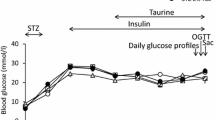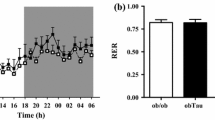Abstract
It has been shown that tungstate is an effective hypoglycemic agent in several animal models of diabetes. In this study, we examined the effectiveness of oral tungstate treatment in a new experimental diabetic syndrome, induced by streptozotocin (STZ) and nicotinamide in adult rats, that shares several features with human type 2 diabetes. Sodium tungstate was administered in the drinking water (2 mg/mL) of control and diabetic rats for 15, 30, 60, and 90 d. Glucose metabolism was explored in vivo by intravenous glucose tolerance test. Insulin secretion and action were assessed in vitro in the isolated perfused pancreas and isolated adipocytes, respectively. Two weeks of tungstate treatment did not modify the moderate hypergly cemia of diabetic rats but reduced their intolerance to glucose, owing to an enhancement of postloading insulin secretion. However, this effect was transient, since it declined after 30 d and vanished after 60 and 90 d of tungstate administration, whereas a trend toward a reduction in basal hyperglycemia was observed on prolonged treatment. Oral tungstate was unable to modify glucose-stimulated insulin secretion in the isolated perfused pancreas, as well as muscle glycogen levels, hepatic glucose metabolism, and insulin-stimulated lipogenesis in isolated adipocytes. Nevertheless, the decreased insulin content of pancreatic islets of diabetic rats was partially restored on prolonged tungstate treatment. In conclusion, in the STZ-nicotinamide model of diabetes, tungstate was unable to permanently correct the alterations in glucose metabolism, despite some indirect evidence of a trophic effect on β-cells. The ineffectiveness of tungstate could be related to the absence, in this diabetic syndrome, of relevant metabolic alterations in the liver, which thus appear to constitute the major target of tungstate action.
Similar content being viewed by others
References
Barberà, A., Rodríguez-Gil, J. E., and Guinovart, J. J. (1994). J. Biol. Chem. 269, 20047–20053.
Barberà, A., Fernàndez-Alvarez, J., Truc, A., Gomis, R., and Guinovart, J. J. (1997). Diabetologia 40, 143–149.
Munoz, M. C., Barberà, A., Dominguez, J., Fernandez-Alvarez, J., Gomis, R., and Guinovart, J. J. (2001). Diabetes 50, 131–138.
Barberà, A., Gomis, R. R., Prats, N., et al. (2001). Diabetologia 44, 507–513.
Novelli, M., Fabregat, M. E., Fernandez-Alvarez, J., Gomis, R., and Masiello, P. (2001). Mol. Cell. Endocrinol. 175, 57–66.
Masiello, P., Broca, C., Gross, R., et al. (1998). Diabetes 47, 224–229.
Weir, G. C., Clore, E. T., Zmachinski, C. J., and Bonner-Weir, S. (1981). Diabetes 30, 590–595.
Giroix, M.-H., Portha, B., Kergoat, M., Bailbe, D., and Picon, L. (1983). Diabetes 32, 445–451.
Portha, B., Serradas, P., Bailbe, D., Suzuki, K., Goto, Y., and Giroix, M.-H. (1991). Diabetes 40, 486–491.
Broca, C., Gross, R., Petit, P., et al. (1999). Am. J. Physiol. 277, E617-E623.
Kuntz, E., Pinget, M., and Damgé, C. (2002). Eur. J. Pharmacol. 448, 167–175.
Fillat, C., Rodríguez-Gil, J. E., and Guinovart, J. J. (1992). Biochem. J. 282, 659–663.
Li, J., Elberg, G., Gefel, D., and Shechter, Y. (1995). Biochemistry 34, 6218–6225.
Le Lamer, S., Poucheret, P., Cros, G., Kiesgen de Richter, R., Bonnet, P.-A., and Cressolle, F. (2000). J. Pharmacol. Exp. Ther. 294, 714–721.
Nadal, B., Fernandez-Alvarez, J., Usac, E. F., and Gomis, R. (1998). Endocrinologia 45, 276.
Li, J., Elberg, G., Sekar, N., He, Z. B., and Shechter, Y. (1997). Endocrinology 138, 2274–2279.
Foster, J. D., Young, S. E., Brandt, T. D., and Nordlie, R. C. (1998). Arch. Biochem. Biophys. 354, 125–132.
Burchell, A. and Cain, D. I. (1985). Diabetologia 28, 852–856.
Penhos, J. C., Wee, C.-H., Basabe, J. C., Lopez, N., and Wolff, F. W. (1969). Diabetes 18, 733–738.
Gerber, P. P., Trimble, E. R., Wollheim, C. B., Renold, A. E., and Miller, R. E. (1981). Diabetes 30, 40–44.
Bergamini, E., Bombara, M., Fierabracci, V., Masiello, P., and Novelli, M. (1991). Ann. NY Acad. Sci. 621, 327–336.
Hassid, W. Z. and Abraham, S. (1966). In: Methods in enzymology, vol. 8. Colowick, S. P. and Kaplan, N. O. (eds.). Academic: New York.
Rodbell, M. (1964). J. Biol. Chem. 239, 375–380.
Moody, A. J., Stan, M. A., and Glieman, J. (1973). Horm. Metab. Res. 6, 12–16.
Chan T. M. and Exton J. H. (1976). Anal. Biochem. 71, 96–105.
Lang, G. and Michal, G. (1974). In: Methods of enzymatic analysis, vol. 3. Bergmeyer, H. U. (ed.). Academic: New York.
Malaisse-Lagae, F. and Malaisse, W. J. (1984). In: Methods in diabetes research, vol. 1. Larner, J. and Pohl, S. L. (eds.). Wiley: New York.
Herbert, V., Lau, K.-S., Gottlieb, C. W., and Bleicher, S. J. (1965). J. Clin. Endocrinol. 25, 1375–1384.
Author information
Authors and Affiliations
Corresponding author
Rights and permissions
About this article
Cite this article
Fierabracci, V., De Tata, V., Pocai, A. et al. Oral tungstate treatment improves only transiently alteration of glucose metabolism in a new rat model of type 2 diabetes. Endocr 19, 177–184 (2002). https://doi.org/10.1385/ENDO:19:2:177
Received:
Revised:
Accepted:
Issue Date:
DOI: https://doi.org/10.1385/ENDO:19:2:177




